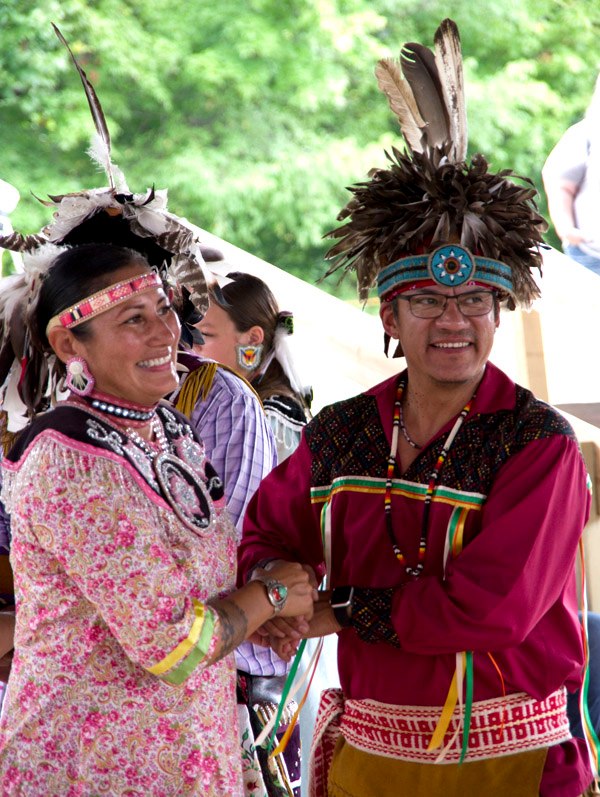
This year's DHPSNY Antiracism Programming takes inspiration from two key resources: the AASLH Making History at 250 Field Guide and the New York State 250th Field Guide. Our guiding question: How do we make our collecting organizations interdisciplinary and representative of the realities of our many New York histories?
This July, our DHPSNY Dialogue, "Building an Inclusive 250th: Pursuing Untold Stories of Everyday Experiences," invited participants to explore strategies for researching undertold, ignored, and poorly documented histories, and how to fill in the gaps in our communities’ stories. In this session, co-facilitators Aria Camaione-Lind (Aria Strategies) and Michael Galban (Ganondagan State Historic Site) encouraged museums, libraries, archives, historical and genealogical societies, and historic sites to step into the difficult work of understanding the Clinton-Sullivan Invasion and its impact. They discussed how colonizers from what is now New York State supported the genocide of Indigenous communities and how subsequent generations have perpetuated the erasure of these communities; and this conversation helped to explore the myth-making surrounding American Independence, which is shaped by how our organizations have historically framed and commemorated the event. The co-facilitators made sure that program participants had an understanding of the Clinton-Sullivan Invasion from the perspective of the most directly impacted community — the Haudenosaunee — to best frame the conversation and give attendees the opportunity to ask relevant questions.
Grappling with the realities of Indigenous genocide, the lasting effects of genocide and erasure, and the ways our organizations have told complicated stories in the past can be points of tension within our organizations and also our wider communities. In order to better consider and navigate the complicated realities in our organizations and communities, staff and volunteers in New York’s collecting organizations are invited to review the recently published New York State Education Department (NYSED) Office of Cultural Education (OCE) DEI Toolkit.
After a competitive selection process in 2022, Aria Strategies worked with a team from the New York State Museum, Library, and Archives (OCE) as well as their stakeholders to determine which tools and supports constituent groups needed to pursue an antiracist and equity-focused lens when looking into their organizations and practices. Over the course of 10 months, the team developed a diversity, equity, and inclusion (DEI) toolkit to complement the DEI tools and resources created by NYSED over the past few years.
The DEI Toolkit includes a tool to help staff and volunteers better facilitate and steward difficult conversations in their organizations and wider communities. It addresses the importance of accomplishing preliminary steps before engaging in conversations, and of approaching this work with compassion, humbleness, and assuming the best intentions from other participants. This tool also helps organizations create a strong framework in which to develop and hold community conversations, and ends with some intentional conversation prompts that can feel supportive and engaging.
Beginning and moderating difficult conversations is an important part of the diversity, equity, inclusion, accessibility, antiracism, and justice work we do in cultural heritage and collections organizations. By more deeply grappling with points of tension in our communities, and inviting difficult conversations from our stakeholders, our organizations are better positioned to interpret and tell complicated, undertold, and/or poorly documented stories.
How will your team use the DEI toolkit to identify which tools can help your organization best prepare for telling undertold and/or poorly documented stories? You can reach us by email at info@DHPSNY.org, or connect with us on the DHPSNY Facebook page or DHPSNY Community Facebook Group.
Click here to access the recorded portion of the session.
Click here to download the slideshow.
Resources for Further Study:
Antiracism from the Indigenous Perspective: Practical Applications, https://www.youtube.com/watch?v=as8DHJJv3t4
Blackhawk, Ned. The Rediscovery of America: Native Peoples and the Unmaking of U.S. History. 2023.
Caring Across Generations. (2020). Conversation Guide: Talking About Race, Racism, Care, and Caregiving. Retrieved from: https://caringacross.org/blog/talking-about-race/
Embrace Race. (2023). Resources. Retrieved from: https://www.embracerace.org/?gclid=Cj0KCQjwlPWgBhDHARIsAH2xdNefZZONPYAPh T92LRuJU28FQzWaWqjj1-797qCLK-doiw2z5WAnnSsaAil4EALw_wcB
Ganondagan State Historic Site, https://parks.ny.gov/historic-sites/ganondagan/details.aspx
National Coalition Building Institute - International. https://ncbi.org/
National Park Service. The Clinton Sullivan Campaign in 1779. https://www.nps.gov/articles/000/the-clinton-sullivan-campaign-of-1779.htm
New York State Office of Cultural Education. DEI Toolkit. https://nyslibrary.libguides.com/dei/home
Oberg, Michael Leroy and Peter Jakob Olsen-Harbich. Native America: A History, 3rd edition. 2022.
Rothstein, R. The Color of Law: A Forgotten History of How Our Government Segregated America. 2017.
Sleeper-Smith, Susan (ed.) et al, Why You Can’t Teach United States History without American Indians. 2015.
Smith, A. Lynn. Memory Wars: Settlers and Natives Remember Washington’s Sullivan Expedition of 1779. 2023.
This post is part of a blog series on sharing information, promoting resources, encouraging discussion, and amplifying the voices of Black, Indigenous, and People of Color (BIPOC) doing antiracism work in archives, museums, history sites, and library special collections. DHPSNY is committed to supporting the diverse network of collecting institutions that safeguard and ensure access to historical records and library research materials across New York State. To learn more, visit our first blog post in the series.
Image: Iroquois Museum Program